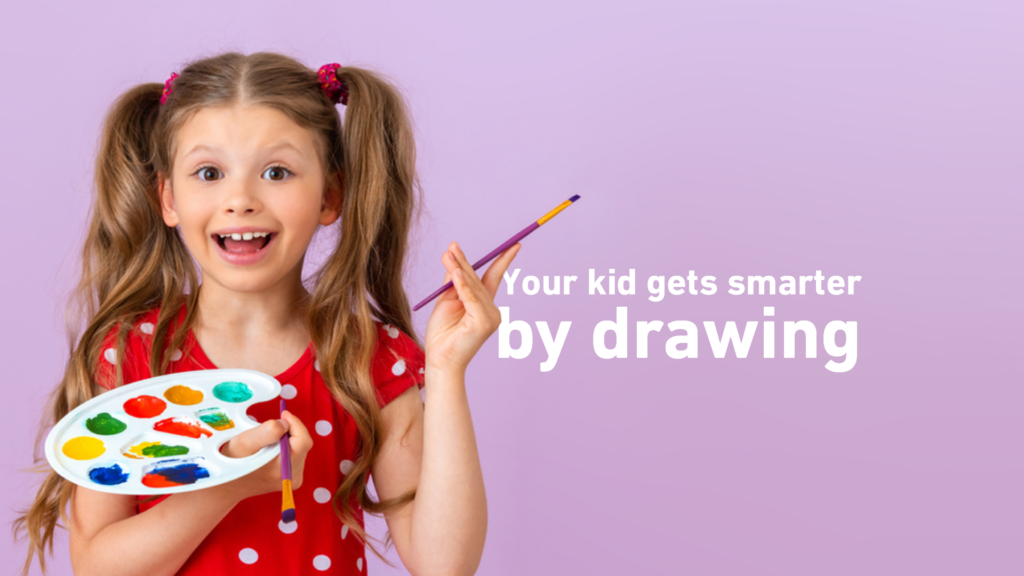
Specialists believe that parents should take their children’s drawings seriously as it implies child intelligence. Based on many stories of parents, they discovered what their children are exposed to outside through their drawings.
Like the story of the mother, Hanan, who found out that her daughter was beaten by her teacher, which led to the teacher being expelled.
Her daughter Salma, at the age of six, used to draw family members including a little girl with braids (her), while keeping their happy faces in all the drawings. that was before she joined the school.
After several months of joining the school, Salma began to draw the little girl with braids playing with another girl, and at other times the girl appears sad and sits alone without friends. Hanan kept following and watching her daughter’s drawings until an old woman appeared in the drawings. That lady was screaming at the girl and she appeared angry.
The mother remembered that on that day her daughter Salma came home, frightened and terrified. This prompted her to visit the school and investigate the matter until she found that her daughter was being bullied at school, which led to the teacher being expelled from work when they discovered that she did this with other children too!
Have you noticed the girl’s intelligence in expressing what makes her sad and happy by drawing? Therefore, child psychologists and researchers believe in the possibility of developing and measuring a child’s intelligence through drawing.
Research and studies have confirmed that children’s drawings carry evidence of their intelligence and mental health. Many parents have found that their children use drawing as a means to express their opinions and feelings instead of speaking about them directly, and there are different languages for children’s drawing. Knowing this, research began to assess children’s intelligence through drawing and measuring their intelligence in more accurate ways.
Teaching drawing to increase child intelligence
One of the first skills that a child learns as soon as he enters the nursery is the use of paper and colors, and thus tendencies to draw and paint appear at the age of 3 to 4 and 5 years. This period is the most important in using children’s rapid absorption of information to develop their artistic and mathematical skills. During this period, the desire for exploration and experimentation appears, allowing them to take quick leaps and accomplish more accurate tasks while learning any of the difficult skills of adults.
When a child is trained at an early age to draw complex drawings such as drawing human beings, faces, and hands, he has more opportunities to develop and develop his drawing skill so that he can become a talented artist at an early age compared to his older peers. It has been found that drawing has languages for children, so let’s get to know them together:
Types of children’s drawing languages
Children’s drawing languages differ during different age stages.
At the beginning of their age, the drawing is incomprehensible, it is a group of lines that are not organized and are seen as if they were scribbles and scribbles. But in fact, the lines represent the feelings of the child while drawing them.
In the second stage, the scribbles develop to contain colors, so you can see the disorganized lines, some of which are in red, some in violet, and some in many lines, and if we notice each color with each line spell, we can form an overview of what the child feels or thinks in general, such as the use of bright colors, we can guess that the child here is overwhelmed with positive feelings of happiness and energy.
The use of dark colors indicates some negative thoughts and feelings. It’s not necessary for the child to know the expression of this or even to understand his drawings themselves and how and why they formed this shape, as his feelings simply push him to draw automatically without analyzing or understanding what is being expressed.
With the development of the age stages and the development of your child’s skills, the stage of drawing with symbols begins, followed by the stage of social drawing, and this is when he begins to draw the people closest to his heart and those with whom he feels intimacy and love, and they are mostly his family, starting with his mother, father, and brothers.
After that, the child’s vision of what can be expressed in drawing develops, so he begins to draw the house, school, streets, doors, and windows, all of which he sees around him on a daily basis.
Therefore, along with the story of Hanan and her daughter, the children’s drawings carry many psychological connotations, and accordingly, specialists advise the need to show the drawings to a children’s psychotherapist to analyze them and understand what they write in their thoughts, especially if the child is secretive and cannot express himself verbally.
Develop your child’s mental abilities by drawing
Drawing and clay develop the skills of pictorial ability or what is known as pictorial intelligence in children, which stimulates their mental development. This is a list of the different skills that drawing stimulates their growth, which makes developing the drawing skill of your children at an early age one of the most important skills that you must motivate:
- Physical skills: It is your child’s ability to control his small muscles to perform certain functions, and this is done by holding a pen and paper and focusing on completing a specific drawing.
- Creative expression: where the child relies on his imagination and memory to express scenes that he may have lived or dreamed of, which prepares him for adulthood in a healthy way.
- Writing skills: The use of pens and paper at an early age is the pre-writing stage and it prepares the child with the basic skills to be ready to use them in writing.
- Coordination skills: Drawing develops the child’s mental skills to coordinate between his hand and his eye to reach specific drawings. This is done by controlling the performance of hand movements while directing his eye.
- Cognitive understanding abilities: The child’s intellectual skills and ability to process information and various concepts, in addition to expressive and spontaneous language, develop
Last word
Today we discussed the importance of drawing in developing your child’s intelligence and preparing him for social life and self-expression. We also discussed several important skills that drawing contributes to. Along with the importance of monitoring and tracking the development of your children’s drawings.. We hope this information was useful to you.
Please don’t hesitate to share your latest children’s drawing with us!
